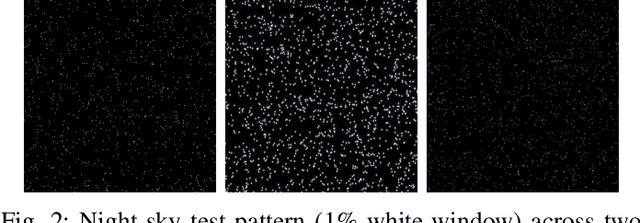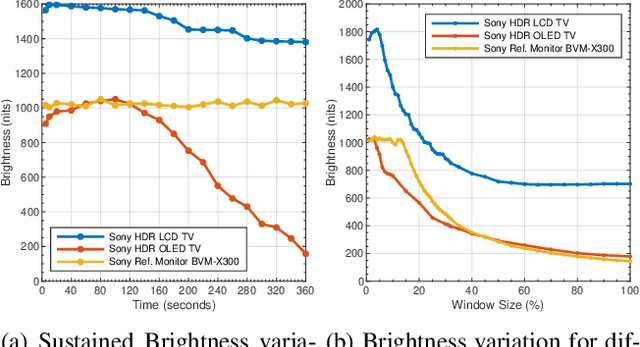Anil Kokaram
Demystifying the use of Compression in Virtual Production
Nov 01, 2024Abstract:Virtual Production (VP) technologies have continued to improve the flexibility of on-set filming and enhance the live concert experience. The core technology of VP relies on high-resolution, high-brightness LED panels to playback/render video content. There are a number of technical challenges to effective deployment e.g. image tile synchronisation across the panels, cross panel colour balancing and compensating for colour fluctuations due to changes in camera angles. Given the complexity and potential quality degradation, the industry prefers "pristine" or lossless compressed source material for displays, which requires significant storage and bandwidth. Modern lossy compression standards like AV1 or H.265 could maintain the same quality at significantly lower bitrates and resource demands. There is yet no agreed methodology for assessing the impact of these standards on quality when the VP scene is recorded in-camera. We present a methodology to assess this impact by comparing lossless and lossy compressed footage displayed through VP screens and recorded in-camera. We assess the quality impact of HAP/NotchLC/Daniel2 and AV1/HEVC/H.264 compression bitrates from 2 Mb/s to 2000 Mb/s with various GOP sizes. Several perceptual quality metrics are then used to automatically evaluate in-camera picture quality, referencing the original uncompressed source content through the LED wall. Our results show that we can achieve the same quality with hybrid codecs as with intermediate encoders at orders of magnitude less bitrate and storage requirements.
Predicting total time to compress a video corpus using online inference systems
Oct 23, 2024Abstract:Predicting the computational cost of compressing/transcoding clips in a video corpus is important for resource management of cloud services and VOD (Video On Demand) providers. Currently, customers of cloud video services are unaware of the cost of transcoding their files until the task is completed. Previous work concentrated on predicting perclip compression time, and thus estimating the cost of video compression. In this work, we propose new Machine Learning (ML) systems which predict cost for the entire corpus instead. This is a more appropriate goal since users are not interested in per-clip cost but instead the cost for the whole corpus. In this work, we evaluate our systems with respect to two video codecs (x264, x265) and a novel high-quality video corpus. We find that the accuracy of aggregate time prediction for a video corpus more than two times better than using per-clip predictions. Furthermore, we present an online inference framework in which we update the ML models as files are processed. A consideration of video compute overhead and appropriate choice of ML predictor for each fraction of corpus completed yields a prediction error of less than 5%. This is approximately two times better than previous work which proposed generalised predictors.
A Sharpness Based Loss Function for Removing Out-of-Focus Blur
Aug 12, 2024Abstract:The success of modern Deep Neural Network (DNN) approaches can be attributed to the use of complex optimization criteria beyond standard losses such as mean absolute error (MAE) or mean squared error (MSE). In this work, we propose a novel method of utilising a no-reference sharpness metric Q introduced by Zhu and Milanfar for removing out-of-focus blur from images. We also introduce a novel dataset of real-world out-of-focus images for assessing restoration models. Our fine-tuned method produces images with a 7.5 % increase in perceptual quality (LPIPS) as compared to a standard model trained only on MAE. Furthermore, we observe a 6.7 % increase in Q (reflecting sharper restorations) and 7.25 % increase in PSNR over most state-of-the-art (SOTA) methods.
A Dictionary Based Approach for Removing Out-of-Focus Blur
Jun 17, 2024Abstract:The field of image deblurring has seen tremendous progress with the rise of deep learning models. These models, albeit efficient, are computationally expensive and energy consuming. Dictionary based learning approaches have shown promising results in image denoising and Single Image Super-Resolution. We propose an extension of the Rapid and Accurate Image Super-Resolution (RAISR) algorithm introduced by Isidoro, Romano and Milanfar for the task of out-of-focus blur removal. We define a sharpness quality measure which aligns well with the perceptual quality of an image. A metric based blending strategy based on asset allocation management is also proposed. Our method demonstrates an average increase of approximately 13% (PSNR) and 10% (SSIM) compared to popular deblurring methods. Furthermore, our blending scheme curtails ringing artefacts post restoration.
Unravelling the Power of Single-Pass Look-Ahead in Modern Codecs for Optimized Transcoding Deployment
Apr 08, 2024Abstract:Modern video encoders have evolved into sophisticated pieces of software in which various coding tools interact with each other. In the past, singlepass encoding was not considered for Video-On-Demand (VOD) use cases. In this work, we evaluate production-ready encoders for H.264 (x264), H.265 (HEVC), AV1 (SVT-AV1) along with direct comparisons to the latest AV1 encoder inside NVIDIA GPUs (40 series), and AWS Mediaconvert's AV1 implementation. Our experimental results demonstrate single pass encoding inside modern encoder implementations can give us very good quality at a reasonable compute cost. The results are presented as three different scenarios targeting High, Medium, and Low complexity accounting quality/bitrate/compute load. Finally, a set of recommendations is presented for end-users to help decide which encoder/preset combination might be more suited to their use case.
A Neural Enhancement Post-Processor with a Dynamic AV1 Encoder Configuration Strategy for CLIC 2024
Jan 31, 2024



Abstract:At practical streaming bitrates, traditional video compression pipelines frequently lead to visible artifacts that degrade perceptual quality. This submission couples the effectiveness of a neural post-processor with a different dynamic optimsation strategy for achieving an improved bitrate/quality compromise. The neural post-processor is refined via adversarial training and employs perceptual loss functions. By optimising the post-processor and encoder directly our method demonstrates significant improvement in video fidelity. The neural post-processor achieves substantial VMAF score increases of +6.72 and +1.81 at bitrates of 50 kb/s and 500 kb/s respectively.
Subjective assessment of the impact of a content adaptive optimiser for compressing 4K HDR content with AV1
Jun 26, 2023



Abstract:Since 2015 video dimensionality has expanded to higher spatial and temporal resolutions and a wider colour gamut. This High Dynamic Range (HDR) content has gained traction in the consumer space as it delivers an enhanced quality of experience. At the same time, the complexity of codecs is growing. This has driven the development of tools for content-adaptive optimisation that achieve optimal rate-distortion performance for HDR video at 4K resolution. While improvements of just a few percentage points in BD-Rate (1-5\%) are significant for the streaming media industry, the impact on subjective quality has been less studied especially for HDR/AV1. In this paper, we conduct a subjective quality assessment (42 subjects) of 4K HDR content with a per-clip optimisation strategy. We correlate these subjective scores with existing popular objective metrics used in standard development and show that some perceptual metrics correlate surprisingly well even though they are not tuned for HDR. We find that the DSQCS protocol is too insensitive to categorically compare the methods but the data allows us to make recommendations about the use of experts vs non-experts in HDR studies, and explain the subjective impact of film grain in HDR content under compression.
Recommendations for Verifying HDR Subjective Testing Workflows
May 19, 2023


Abstract:Over the past few years, there has been an increase in the demand and availability of High Dynamic Range (HDR) displays and content. To ensure the production of high-quality materials, human evaluation is required. However, ascertaining whether the full playback pipeline is indeed HDR-compliant can be challenging. In this paper, we present a set of recommendations for conformance testing to validate various aspects of the testing workflow, including playback, displays, brightness, colours, and viewing environment. We assessed the effectiveness of HDR conversion techniques used in current standards development (3GPP) for making source materials. Additionally, we evaluate HDR display technologies, including OLED and LCD, using both consumer television and a reference monitor.
Filling the gaps in video transcoder deployment in the cloud
Apr 17, 2023Abstract:Cloud-based deployment of content production and broadcast workflows has continued to disrupt the industry after the pandemic. The key tools required for unlocking cloud workflows, e.g., transcoding, metadata parsing, and streaming playback, are increasingly commoditized. However, as video traffic continues to increase there is a need to consider tools which offer opportunities for further bitrate/quality gains as well as those which facilitate cloud deployment. In this paper we consider preprocessing, rate/distortion optimisation and cloud cost prediction tools which are only just emerging from the research community. These tools are posed as part of the per-clip optimisation approach to transcoding which has been adopted by large streaming media processing entities but has yet to be made more widely available for the industry.
Comparison of HDR quality metrics in Per-Clip Lagrangian multiplier optimisation with AV1
Mar 28, 2023

Abstract:The complexity of modern codecs along with the increased need of delivering high-quality videos at low bitrates has reinforced the idea of a per-clip tailoring of parameters for optimised rate-distortion performance. While the objective quality metrics used for Standard Dynamic Range (SDR) videos have been well studied, the transitioning of consumer displays to support High Dynamic Range (HDR) videos, poses a new challenge to rate-distortion optimisation. In this paper, we review the popular HDR metrics DeltaE100 (DE100), PSNRL100, wPSNR, and HDR-VQM. We measure the impact of employing these metrics in per-clip direct search optimisation of the rate-distortion Lagrange multiplier in AV1. We report, on 35 HDR videos, average Bjontegaard Delta Rate (BD-Rate) gains of 4.675%, 2.226%, and 7.253% in terms of DE100, PSNRL100, and HDR-VQM. We also show that the inclusion of chroma in the quality metrics has a significant impact on optimisation, which can only be partially addressed by the use of chroma offsets.
 Add to Chrome
Add to Chrome Add to Firefox
Add to Firefox Add to Edge
Add to Edge